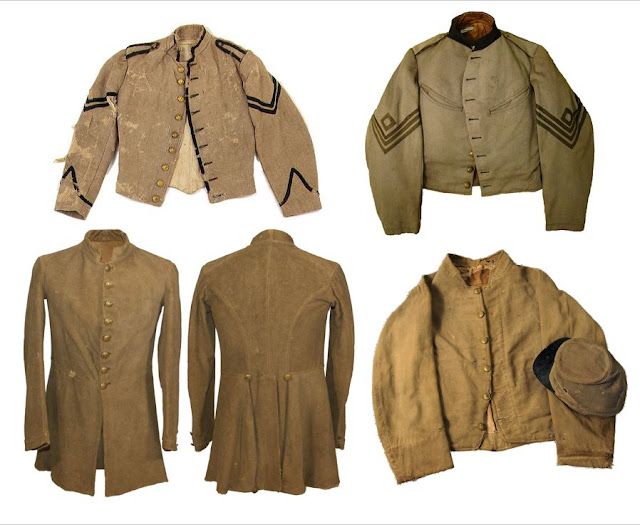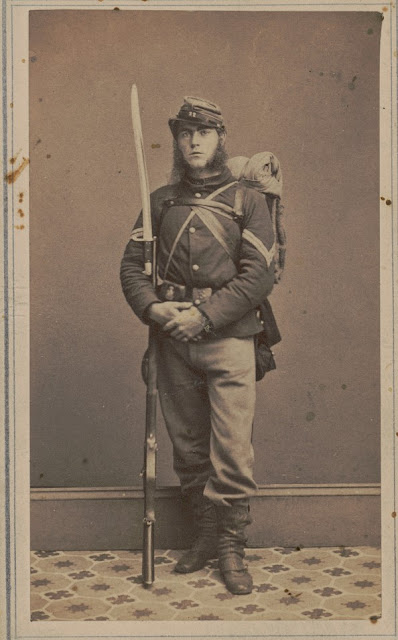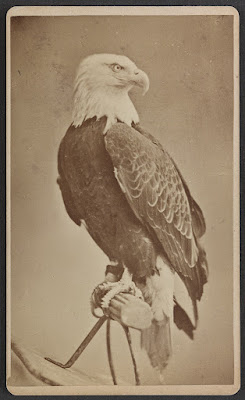Draw Your Sabers and Weigh In: Stopping the Rout at Corinth
One of the most important roles played by cavalry during a battle was to serve as provost guards, providing security behind the lines by stemming the flow of men from the battle line. Sergeant Willard Burnap of the 2nd Iowa Cavalry told how his company prevented a rout at the Battle of Corinth in October 1862.
“We received orders to station ourselves in the rear of the
line of battle and stop all soldiers and officers from going to the rear unless
they were wounded or belonged to the medical staff,” he wrote. “This is one of
the most important positions that can be assigned to a company on the
battlefield. We were scarcely in line when the 80th Ohio regiment,
broken, demoralized, and panic-stricken, came rushing back like frightened sheep.
Other regiments, missing their support and knowing the danger when their line
was broken, seemed ready to follow. That regiment must be stopped or the day is
lost! I was nearest to them and putting the spurs to my horse was soon among
them. In an instant, I was surrounded by a dozen or more of our company and
succeeded by entreaties, commands, and threats in stopping them. Their officers
formed them and in turn rallied the rest as they came up. The last I saw of them;
they were forming into line of battle with a cheer.”
Sergeant Burnap wrote the following letter to his uncle Rev. E.G. Howe who shared it with the editors of the Waukegan Weekly Gazette; it ran on the first page of their October 25, 1862, issue.
Corinth,
Mississippi
October 8, 1862
Dear uncle,
Since my last, the Army of the
Mississippi has been again victorious. One of the most splendid victories of
the war has been achieved here. The slaughter of the Rebels was tremendous;
their wounded cover an extent of ground larger than your public square being
placed in tents as close as they can be set and each one filled to overflowing.
I don’t know how many prisoners we have but the town is full of them.
The battle lasted two days, October 3rd and 4th,
and the pursuit is still going on. We have captured the baggage and ammunition
trains of the enemy, some of his artillery, and hopes are entertained of
getting it all. The hottest of the fight was the morning of the 4th
when the enemy concentrated all of his strength in one desperate charge,
determined on entering the town for Price told them (so say the prisoners) that
they should take dinner in Corinth.
At daylight on the morning of the 3rd, I was three
miles south of Jacinto in charge of a patrol when we had the first intimation
of the attack on Corinth by hearing the cannonading in that direction. When I
returned to camp, I found that the company, which had been left at Jacinto
until the commissary stores were removed, had received orders to rejoin the
battalion three miles back. We joined the battalion, taking with us 17
Mississippians who had volunteered in the Federal army and proceeded to Corinth
where we arrived late in the afternoon. The fight was then going on just
outside of the breastworks on the west end of the town. It continued until too
dark to see when both sides ceased firing and rested on their arms.
At the first break of dawn, a Rebel battery which had been
run up and taken position during the night, opened fire, throwing shells
directly into town and causing a general stampede of hospitals, sutlers,
citizens, etc., but not of soldiers. Soon after daylight our company was
ordered to report to General Rosecrans in person. We proceeded through the town
until we reached quarters. The fire of the Rebels had slackened some and two or
three siege guns seemed to be taking all of the responsibility of the battle on
our side.
 |
| The colors of the 2nd Iowa Cavalry call out their participation in the Battles of Farmington, Boonville, Iuka, and Corinth, all located in northeastern Mississippi. |
We received orders to station ourselves in the rear of the
line of battle and stop all soldiers and officers from going to the rear unless
they were wounded or belonged to the medical staff. This is one of the most
important positions that can be assigned to a company on the battlefield. If
one good company of cavalry had been placed in the rear of each brigade at the
Battle of Bull Run, there would never have been a stampede as cowards are the
ones who commence stampedes and if they are kept in ranks, the brave will
certainly not run. Often a stampede which would if allowed to go on would
demoralize a whole army. If halted in its commencement, it may be stopped by
one determined mounted man who has a good saber and is not afraid to use its
side, back, and (if necessary) its point and edge upon dastardly cowards who
would run and leave their comrades to fight it out.
I was assigned to the command of the first platoon and
stationed it as skirmishers at 15 paces intervals in rear of and overlooking
two regiments of infantry and one regiment of sharpshooters. The firing by this
time had re-opened and soon after we had the pleasure of seeing a Rebel gun
brought into our lines and the battery which was shelling the town silenced.
After the battery was silenced, the firing was confined to the sharpshooters in
the woods and they slackened so much that there began to be a general opinion
that they had given up the attack. We were recalled from our position and
dismounted at headquarters to await events. It soon became apparent that though
silent they were not idle but were preparing for a general advance along the
whole line. Our right was in danger!
All was activity as artillery and infantry rushed to the
right. We were ordered to mount and support a battery. And we, with the rest,
rushed to the right following close upon the guns we were to support. Just then
the battle opened. The Rebels charged in solid columns upon our works. Volley
after volley of musketry is poured into their ranks and are answered by shot,
shell, and musket balls with interest. Still, we go to the right under a heavy
fire, past thundering batteries and staggering columns of infantry and reached
the extreme right not a moment too soon. That flank is nearly turned; the
battery it supports is taken, the lines of infantry are wavering, recoiling,
almost breaking. The Rebels by the thousands stand upon the breastworks of the
captured battery and cheer on column after column of their comrades as they
throw themselves reckless of life upon our outnumbered infantry. It was the
critical moment of the battle. In 10 minutes, one side or the other must be
victorious.
 |
| General William S. Rosecrans commanded the Federal forces at Corinth in October 1862. That victory propelled him into his next assignment commanding the Army of the Cumberland. |
Quicker than thought our battery wheeled into line and
unlimbered, the gunners springing from the caissons and putting their shoulders
to the wheels. In an instant, they had the guns in a raking position throwing
shot and shell, grape and canister, terror and death amidst the ranks of the
ever-exultant enemy. At the same moment, the battery wheeled into line, we received
orders to deploy as skirmishers and stop the stream of cowards who were leaving
their posts. “Draw your sabers and wade in,” said Rosecrans’ aide-de-camp just
as we were deploying.
We were scarcely in line when the 80th Ohio
regiment, broken, demoralized, and panic-stricken, came rushing back like
frightened sheep. Other regiments, missing their support and knowing the danger
when their line was broken, seemed ready to follow. That regiment must be
stopped or the day is lost! I was nearest to them and putting the spurs to my
horse was soon among them. In an instant, I was surrounded by a dozen or more
of our company and succeeded by entreaties, commands, and threats in stopping
them. Their officers formed them and in turn rallied the rest as they came up.
The last I saw of them; they were forming into line of battle with a cheer.
They other regiments, cheered by the timely opening of our battery and finding
their line still firm, redoubled their energy and in five minutes the battery
was retaken and was thundering sweet music and death to them.
But hark, even over the roar of musketry and thunder of the
cannon, away on the left, you can hear it swell. Cheer after cheer; now it
rolls along the line. Regiment after regiment take it up and brigade after
brigade passes it along. What is it? Now the right, which a moment ago was
silently, desperately and doggedly fighting against fearful odds, seems
electrified and pausing in the conflict gave three such hearty cheers that rend
the sky and fall to work again with redoubled force.
What does it mean? The Rebels are faltering, wavering,
breaking! First the left, then the center, and finally on the right they give
ground. The army which a short time ago was advancing in solid columns and
well-ordered lines is now recoiling in one confused mass. The fire of our
artillery slackens; the infantry soon followed by the artillery advance and
plunge into the woods after the retreating foe. The battle has ended and the
pursuit begun.
Since we came to Corinth our horses have nearly starved; we have had only two or three feeds since we came here. We remain here as picket guards for the town. I don’t know where the regiment is but probably after the Rebels.
To learn more about the Battle of Corinth, please check out these posts:
Brigham's War: Letters from the 27th Ohio Infantry, Part III
Interview with Brad Quinlin and the story of Pierre Starr, 39th Ohio Infantry
Source:
Letter from Sergeant
Willard A. Burnap, Co. I, 2nd Iowa Volunteer Cavalry, Waukegan
Weekly Gazette (Illinois), October 25, 1862, pg. 1











Comments
Post a Comment